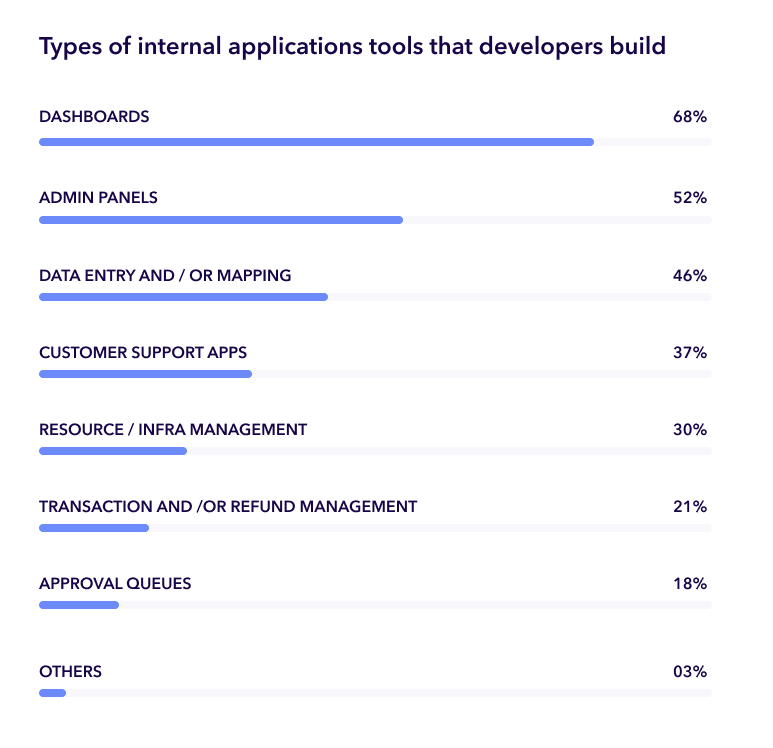Why build Internal Tools when No Code solutions exist?
The Current State of Internal Tooling
Internal tools are critical to the optimal productivity of a modern business. From CRUD interfaces to project and process-specific platforms and operational tools, the development of internal tools using your own developers is often inefficient. Creating internal tools using No Code platforms/SaaS software is an excellent alternative, which results in customized solutions that are cost-effective, and efficient for companies to address their functional requirements. Internal tools are critical because they accommodate the nuances that customize solutions to an organization’s needs. This requirement will only persist and evolve, in the years ahead.
According to a recent survey, developers spend 34% of their time developing internal tools - with that number rising to 45% for businesses with more than 5000 employees; 85% of respondents expect to retain or increase, their current level of investment in this space. This should come as no surprise, given the scope of internal tools. They allow organizations to integrate disparate data systems to enhance efficiency and informed decision making, secure mission-critical data, and customize reporting to meet internal standards and organizational structure.
The Case for Internal Tooling
What sets internal tools apart from the run-of-the-mill solutions and interfaces one can buy from vendors, is specificity. Creating internal tools within the organization ensures that they are optimal for the processes and the workforce in play. There are many ways to create internal tools: using a team of internal developers, the B2B SaaS approach, and lately through No Code platforms.
Of the available options, using developers within the organization runs the risk of the tool becoming redundant very soon. In a recent survey, 20% of respondents cited lack of ownership and lack of clarity around tying the impact of tools to revenue, as major problems. Interestingly, this sentiment was higher among technical personnel (31%) than those in a non-technical role (22%) (.
In contrast, the No Code development process makes it possible for businesses to develop inexpensive bespoke solutions, without relying on a team of experienced developers, with the leeway to create highly customized solutions that standard tools cannot deliver. Some of the more popular applications for internal tools include:

⦁ CRM
⦁ Dashboard and Database GUI
⦁ Data Entry
⦁ Admin Panels
⦁ Customer Support Apps
⦁ Approval Apps
⦁ Inventory Apps
Research indicates that the global market for workplace collaboration software is projected to grow at a CAGR of 13.2% till 2027, to assume a market size of $35.71 billion. However, the picture isn't all rosy. Teams building internal tools do report issues and challenges as well.
Nearly 60% of the respondents to a recent survey about the challenges around internal tools felt they didn't have enough resources to develop such solutions. Matters are further complicated because the data internal tools depend on changes constantly – an issue that is particularly challenging for AI teams that deal with vast volumes. As AI grows and becomes more nuanced, the need to process more data types – from an ever-expanding range of sources – will increase these complexities further.
The No Code Disruption
Despite the challenges, the rise of the No Code approach to developing internal tools is transforming both their volume and ability to resolve to use case-specific issues. Building a minimum viable product (MVP), with low overheads, creates room for constant innovation and enhanced operational flexibility. The solution's features can be continually tweaked in response to user experiences and quantifiable outcomes. For instance, Groupon founder and CEO Andrew Mason launched the company beginning with a single landing page – a resource that a non-IT employee can build quickly in a No Code world, using one of much available drag and drop solutions and templates.
No Code and Drag and Drop solutions not only make the development of internal tools easier, they are also emerging as a significant factor in accelerating digital transformation by, speeding up the process, lowering the cost of development, and allowing end-users to leverage their real-world expertise to develop highly specific and bespoke internal tools.
Democratizing AI through No Code solutions
No Code solutions are vital to enabling the widespread adoption of AI by reducing the cost of entry for businesses. Typically, organizations are forced to retain Machine Learning experts, making it challenging to leverage the advantages offered by a transition to AI-based solutions.
The No-Code alternative presents a much more accessible route, democratizing AI and allowing businesses to overcome talent gaps.
The emergence of No Code and Low Code platforms is particularly significant for SMEs - who typically have no data science teams or very limited ones. They help smaller firms remain competitive in a market transformed by the advent of AI and Machine Learning. In turn, the sheer volume of such businesses, will establish No Code platforms as critical components in the AI ecosystem and allow them to scale their machine learning operations.

There has been a steady and growing adoption of No Code tools for both internal purposes and other applications. To run successful machine learning operations, businesses should own the entire stack of technologies, from data procurement to deployment.
Ideally, their No Code solutions should enable:
⦁ Collection and Labeling of Data
⦁ The Machine Learning infrastructure needed to train models
⦁ The hardware for the Machine Learning models to run on
While businesses have invested huge amounts of money in Machine Learning infrastructure and hardware, their labeling infrastructure is often under-represented in budgetary estimates.
However, procuring good quality labeled data is foundational to data science, without which the other two pillars become redundant. Organizations cannot keep up with the changes if they use specialist developers for internal tools or a suite of enterprise tools. There is a need for customizable No Code labeling solutions, to generate training data that enables:
⦁ Quick POC turnarounds
⦁ Shorter setup and onboarding timeframes
⦁ Hands-on input from subject matter experts to create interfaces and solutions that best fit the organization
The effectiveness of Machine Learning operations are tied to the quality of labeled data being used, which is in turn dependent on the procurement and management of this critical resource.
Taskmonk empowers AI teams and Machine Learning developers by ensuring the highest standards in data labeling and streamlining its procurement, to help create better AI, faster.

Taskmonk: A Labeler Centric No Code Data Labeling and Procurement tool
Taskmonk's greatest strengths are its highly customizable nature, with the ability to leverage cloud economics across a truly diverse range of use cases. Multiple data sources typically challenge enterprises dealing with vast volumes of raw data because of ineffective communication across siloed functions and teams. Coupled with inefficient resource usage, these lead to mounting budgets.
Resulting in what Taskmonk refers to as, 'Fractured Labeled Data Procurement Pipelines.' With the situation only going from bad to worse, the entities involved multiply, and the AI use case becomes more complex and nuanced.
An estimated 40,000 hours of training required to train AI with a 25-second video input
Such a fragmented approach can directly undermine the quality of the AI solution being deployed. What's worse, troubleshooting the eventual solution can add to the complexity and tedium, with an estimated 40,000 hours of training required to train AI with a 25-second video input! Such challenges underscore why data collection and management are often the top concerns in AI development.
Harnessing the Taskmonk Expertise
Taskmonk brings a decade of data labeling and procurement expertise, gained over countless use cases in multiple industries, environments, and applications to create the perfect platform for handling the constantly evolving nuances of AI development. Taskmonk's value proposition is further enhanced by the fact that it has been purpose-built for eCommerce enterprises, with the ability to handle complex product taxonomies and specific requirements that labeling workflows in the industry bring.
The finesse with which Taskmonk handles multiple data types and use cases within eCommerce has allowed the company to develop robust and versatile solutions appropriate for users across many industries.
Taskmonk operates from the knowledge that, centralizing the procurement and labeling of data is a critical function, determining the extent to which AI can be deployed optimally. AI and Machine Learning are set to revolutionize eCommerce, and Taskmonk believes that effective data labeling will play a critical role in ensuring their successful deployment.





